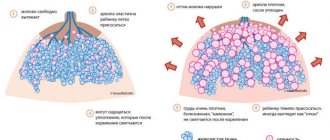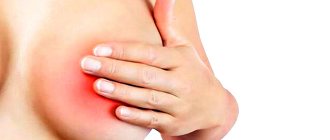It's no secret that breastfeeding is a priority for a child's nutrition. And the mother’s health only benefits from this. According to WHO, early breastfeeding (within an hour after the baby is born) reduces the risk of illness and mortality in infants. The first milk, colostrum, is rich in substances that have protective properties. Mother's milk is not only best absorbed by the baby, but also helps him cope with many diseases.
But there are times when the amount of milk suddenly drops or its production stops altogether. Why did the milk disappear and how to resume lactation, what to do in such situations?
Why might lactation stop or decrease?
Only 5% of women experience a true disappearance of lactation, which manifests itself against the background of hormonal changes.
The mother’s body tries to fight to the end and provide her baby with adequate nutrition. The following factors are identified that negatively affect lactation:
- The woman psychologically does not want to continue feeding.
- The presence of severe stress or constant emotional stress.
- Poor diet or lack of fluid.
- The baby does not have regular access to the breast.
- The woman does not adhere to a specific feeding schedule.
- Groundbait was introduced into the child’s diet too early.
Breast milk can disappear suddenly, even if the child already has a well-established feeding mechanism.
A lactation crisis occurs in almost every woman, especially during the period of introducing complementary foods into the diet.
As a rule, this period occurs at the end of the first month. To overcome the problem, doctors recommend putting the baby to the breast as often as possible. Read more about the reasons for the deterioration of lactation here.
Partial stoppage of milk production
Quite often, women who are breastfeeding notice that the milk supply has become much worse than before, and they come to the false conclusion that there will be no more milk, and so that the baby does not remain hungry, it is necessary to urgently begin feeding from a bottle. This is an absolutely false conclusion based on basic ignorance of the physiological processes occurring in a woman’s body when feeding a baby with breast milk. Restoring lactation is necessary and possible if it is carried out with awareness of the problem, patience and the most effective measures.
Quite often, women who are breastfeeding notice that their milk supply has become much worse than before, and come to the false conclusion that there will be no more milk.
The first signs of malnutrition in a baby
Milk begins to disappear if you notice the following signs in your baby:
- Over the past month, the baby has not gained enough weight.
- The baby is capricious and nervous for no reason.
- During the day, less milk is produced.
- Urination began to occur much less frequently. With normal feeding, a wet diaper should be used at least eight times a day.
If you do not find these symptoms, then your worries are groundless. Otherwise, you should look for a way to restore the previous volume of lactation.
Producing hormones through actions
A nursing mother should remember a few simple truths: the more often and longer the baby suckles, the more actively her mammary glands begin to work. In no case should the baby be forcibly removed from the breast; it is necessary to give him the opportunity to carry out the sucking process as much as he needs. The pacifiers used lead to the baby actively sucking on the empty rubber, expending effort and energy on this, as a result of which his activity during feeding decreases. In the first weeks, it is necessary to limit water from the bottle so that the newborn receives all the necessary substances from the mother's breast and actively seeks and uses it for this.
Expressing milk is the same necessary measure as breastfeeding by a baby, and its purpose is not only to prevent congestion, but also to develop the mammary gland, milk flow, stimulate the production of hormones responsible for the production of baby food, and improve the functioning of the nipple. At the same time, each correctly performed feeding provides an opportunity to take one more step towards increasing this function.
Prompt solution to the problem
At the first stage, if the milk has not yet disappeared, try to give the baby access to the breast as often as possible. He will have to move away from his usual schedule, even if he is already accustomed to a certain schedule. It is important to satisfy your baby’s hunger as soon as it appears.
The body of a nursing mother will instantly react and begin to produce milk in larger volumes. There is a misconception that if you feed your baby less often during the day, there will be more left for the night. A woman’s body works well only if the child actively consumes the lactation product.
A mother’s love for her child and round-the-clock care for him will help restore the process.
Women claim that milk actively rushes to their breasts as soon as they hold their baby in their arms. Therefore, try to perform this action more often and supplement it with conversations and songs. Love will trigger a natural mechanism at any moment.
What to do to restore lactation:
We recommend reading: Nutrition when feeding an infant
- Increase daily water consumption to 2 liters. Fluid plays a significant role in restoring lactation. You can drink water, compote, tea and milk.
- Analyze your diet. It should supply the body with a sufficient amount of minerals and trace elements. Vitamins also play a significant role in this process.
- A woman must develop a clear daily routine for herself. At the same time, you should avoid stress and get good rest. If you feel that you are very tired, then ask your family and friends for help. Relax your body. Psychologists recommend taking a warm bath, listening to music or going shopping.
- Fresh air will not only help return milk, but also restore physical fitness after childbirth. Take regular walks in the park or on the street, and take your stroller with you.
- If a significant decrease in lactation is noticed, then the baby should be fed formula for 7 days.
- Check your baby's health, as he may have difficulty breathing through his nose.
- When feeding, take the correct position, control the baby's position and hold the nipple well.
Risk factors
Mothers
They are the most common problems why milk disappears. These could be reasons such as
- inflammation and damage to the nipples
- poor breastfeeding
- mastitis
- flat or inverted nipples , etc.
In addition, a discrepancy between the size of the nipples and the size of the baby's mouth can create problems that require a quick solution, without which milk production can quickly decline.
Side effects, certain diseases, conditions and habits of the mother that affect the loss of breast milk :
- anemia,
- thyroid diseases,
- polycystic ovary syndrome,
- insulin-dependent diabetes mellitus,
- underdevelopment of glandular tissue of the breast,
- surgery (breast reduction, correction),
- residual placenta,
- obesity.
- C-section
- smoking
- stress
- contraceptives
- drug use during pregnancy, during childbirth and later.
child
- premature birth
- baby with impaired coordination of sucking (swallowing), breathing
- baby's illness
- congenital malformations such as cleft lip or cleft palate
- baby behavior
- child's temperament
Common problems
In some cases, when the mother already has a satisfactory amount of milk or she is quite capable of creating it, something happens that can disrupt the physiological process. The most common examples are
- separation of mother from child,
- sudden hospitalization of mother or child,
- bottle feeding babies,
- complementary feeding with milk replacement, etc.
When a mother’s milk disappears, the baby becomes fussy after feeding or often cries, and out of fear that the baby is hungry and to calm him down, mothers give him food from a bottle to replace milk. This leads to disruption of the natural “calibration” of the breast and, consequently, to a decrease in milk production.
Traditional methods
You can restore lost milk by using recipes tested by our grandmothers:
- Caraway drink. 5 grams of seeds are poured with one hundred grams of sour cream. The composition must be brought to a boil. Instead of the last ingredient, you can use milk. The syrup is consumed cold, 1 tbsp. l. before eating. The procedure is repeated three times a day.
- Nettle. You can purchase ready-to-use herbal leaves at your nearest pharmacy. For the composition you will need to take 1 tbsp. l. and fill it with 200 milliliters of boiled water. To obtain maximum effect, the decoction must be well infused. Use three times a day after meals.
- Carrots and milk are the main source of vitamins. The vegetable is grated and poured with 200 milliliters of milk. The composition is infused. You should consume one glass half an hour before feeding.
Mistakes moms make when lactation fades
Some mothers, when lactation is fading, rush to supplement their baby with formula. This is not true. The baby quickly gets used to eating through the nipple, and then does not want to strain and suck on the breast. As a result, more and more often you have to give him formula and less and less milk is produced.
A child walks on his toes - reasons (Komarovsky) and methods for correcting gait.
How important is the NGS procedure of the newborn brain, what can it reveal?
If there is a temporary decrease in milk production, you may not be able to feed your baby for 2-3 days. This will not affect his health in any way, and in the meantime lactation will be restored. If there is a need to give your child more to drink, use a teaspoon.
If, for medical reasons, it is temporarily impossible to feed the baby, then it is necessary to express milk. This should be done not once a day, but 8-9 times.
Then lactation will not decrease. It is better to use a breast pump to express, although you can do it with your hands. How to express milk correctly - read the material at the link.
When your breasts harden, you need to continue to feed your baby. If necessary, also express milk until you feel relief.
Do not use pacifiers or pacifiers to soothe your baby. Better offer him your breast.
Many mothers are frightened by the fact that they have to spend all their time with the child, they are quickly tired of it, and they are just looking for an excuse to transfer the child to artificial feeding.
It is important how the mother is determined, whether she wants to make efforts to return lactation or whether it is easier for her to decide to switch the child to formula.
You will also find other material on this topic useful - how to wean a child from breastfeeding at night?
Using ready-made funds
If a woman begins to lose breast milk, then she can use special teas, the effect of which is aimed at stimulating its production. The most popular among them are:
- “Hipp” is a special tea that is prescribed to a nursing mother. Its composition is absolutely harmless, since it consists of ordinary herbs. Lactation can be increased through the interaction of fennel, lemon balm, nettle, caraway and anise. Please note that a woman who has an individual intolerance to the component should not drink it. To achieve the effect, you need to drink one glass of hot drink once a day. The granules dissolve easily in water, so there will be no problems with preparation.
- “Babushkino Lukoshko” is a tea bag containing 20 tea bags. You can choose the option according to your taste between rosehip or anise. To restore lactation, it is recommended to use one tea bag four times a day. The composition must sit for 10 minutes before use. To date, the tea has received only positive reviews, and not a single side effect has been identified. The only drawback is that women with rosehip allergies should not drink this tea.
- Lactavit is another tea option that is sold in a pack of 20 bags. The composition contains components that will help if breast milk has disappeared. Ingredients: cumin, fennel, anise, nettle. Experts recommend drinking the brewed mixture 30 minutes before feeding. You can use 1 to 2 sachets per glass. Depending on the results obtained, the course of treatment can last from 2 to 4 weeks.
The following dietary supplements and homeopathic remedies are most in demand among mothers:
- Dietary supplement "Lactogon" - special tablets, of which there can be 10 or 50 in a package. The choice of option depends on the woman’s condition. The composition includes natural royal jelly, carrot juice, oregano, dill and other useful ingredients. They have only a positive effect on a woman’s body. No side effects. You should take one tablet regularly three times a day with food. The drug has excellent reviews. Mothers notice an increase in the amount of milk already on the third day of use.
- The dietary supplement "Apilak" is a special biogenic stimulant. For ease of use, it is available in tablet form. To date, no contraindications to its use have been identified. Doctors prescribe it to nursing mothers who are currently experiencing a decrease in milk supply. The main active ingredients are royal jelly, vitamin B, folic acid, various minerals and amino acids. The drug is taken one tablet three times a day with food. A positive effect can be achieved by completing a course of treatment of two weeks. Unfortunately, there are a number of side effects: insomnia and dry mouth. You should not take this product if you are allergic to honey or other ingredients of the composition.
- “Mlekoin” is a homeopathic remedy that is produced in the form of granules for ease of use. The composition includes only healthy ingredients: lumbago, nettle, vitex. Sugar is used as an auxiliary component. The drug is harmless to the woman’s body and does not cause side effects. You can take the drug all the time while breastfeeding. It is allowed to consume no more than five granules twice a day. The best effect can be achieved if each granule is thoroughly dissolved in the mouth.
How to understand: symptoms of milk shortage and burnout
It is not enough to just breastfeed your baby; you need to be sure that the baby is getting enough nutrition. The full physical and mental development of the baby depends on sufficient receipt of all necessary vitamins and useful elements. But if lactation decreases, the baby does not receive enough valuable fluid. In this case, it is necessary to do everything to increase milk production or supplement the baby with formula.
Doctors pay attention: very often mothers only think that the baby is not eating enough. Actually there is no problem.
Reliable signs of lack of milk
But it's better to be safe and check. Experts identify reliable signs of a lack of breast milk:
- I am diagnosing my child as underweight. Once a month, children under one year of age are seen by a pediatrician. At the appointment, the doctor will weigh the baby and measure its height. Then he compares this data with the child’s age. If the baby weighs below normal, it means he does not have enough nutrition;
- a small amount of urine is released. A wet diaper test is recommended. Normally, a baby urinates ten or more times, depending on age. If the number of urinations is less than 10, this is a reason to consult a doctor.
Experts explain that when a child is sick, the number of urinations decreases, even if he has enough milk. It is therefore inappropriate to perform the test when the infant is in this condition. You should wait for complete recovery and only then draw conclusions.
Weight loss is one of the main signs of milk deficiency
If a mother observes one or more reliable signs in the baby, this is a reason to urgently consult a doctor. It is possible that the pediatrician recommends supplementing the baby with formula to compensate for the lack of nutrients in his body.
Possible signs of insufficient breast milk
There are also possible signs that the baby is not getting enough milk. However, doctors explain that even if these symptoms are detected, it is not necessary that the baby is malnourished. Perhaps the problem is completely different. This is just a signal to action for the mother to pay attention and consult with a specialist, if necessary. These signs include:
- baby is dissatisfied after feeding. He looks for the nipple, abruptly throws it away and again attaches himself to the breast. The baby is capricious, cries, and is overexcited;
- a woman cannot express fluid after the baby has already eaten;
- The baby spends a long time at the breast. He wants to get more milk, but he can't;
- The mammary glands do not enlarge during the milk flow before feeding. Usually a woman feels that the fluid is coming, especially if the break between feedings is three to four hours. When the milk burns out, the breast remains soft due to the small amount of milk in the mammary gland.
Video: consultation with a doctor about lack of milk during breastfeeding
Useful and effective tips
To restore the normal amount of milk produced, it is not enough to just take medications. A woman should provide herself with a sufficient amount of fluid during the day. It is advisable that it be warm. Remember to drink plenty of fluids at least five times a day.
Do not overeat fatty foods. All meals for a nursing mother should be fairly balanced, but not too high in calories.
To stimulate lactation, you should regularly drink tea with milk and nuts. These components will protect the nervous system from stress and allow you not to worry about little things, but to constantly be with your child
In the human body, the hormone oxytocin is responsible for tender feelings. When a baby is frequently put to the breast, it begins to be actively produced in the mother's body. Therefore, try to spend more time with your baby together. The hormone is produced more actively at night and in the morning.
Regular intake of the necessary medications and proper nutrition, sleep and rest patterns will lead to the restoration of lactation. The child should be fed at least eight times a day. If necessary, increase the number of applications up to ten times.
Reasons for the decline of lactation
Lactation is the production of
milk for feeding a newborn. Breast milk is the most correct and adequate nutrition for a baby.
Natural feeding (breastfeeding) is not only beneficial for the baby, but also convenient for the mother. Food is always at hand and you can feed your baby at any time. There is no need to spend money on an adapted formula, cook it or heat it, boil bottles and nipples, and there are many other advantages.
A child fed by mother's milk has fewer problems both physically and psychologically.
But it happens that lactation fades away. The reason for this condition may be the following:
- Incorrect organization of breastfeeding . You should not stick to feeding by the hour, with a long interval at night, supplement your baby’s water unnecessarily, supplement feeding with formula if it seems that there is not enough milk, you need to learn how to properly put the baby to the breast, and more.
- Overwork and stress in a nursing mother . Young mothers often get nervous about every little thing, try to combine child care and household chores, sleep little, get very tired and, as a result, become overworked and stressed.
- Illness of the mother, during which she is forced to stop feeding . For medical reasons, you should not feed your child while taking the medicine.
- Separation of mother and baby during which feeding is not possible. For example, mom was admitted to the hospital or she went on a business trip.
- Lactation crisis – milk production may temporarily decrease. Lactation sometimes decreases and sometimes increases. Sometimes it does not keep up with the child’s growth. Mature lactation is usually established after three months.
Interesting Facts
Breastfeeding has the following positive effects on the baby's body:
- Strengthening the immune system.
- In the future, the child will have well-developed thinking abilities.
- An additional inextricable bond is formed between mother and baby.
- The likelihood of diabetes mellitus decreases.
- Prevention of the development of diseases associated with blood pressure.
- The baby will not suffer from depression and stress.
- Prevention of many diseases.
- Reducing excess weight.
Breastfeeding is a gift that only women are endowed with. Such children grow up healthy and happy. That is why do not stop fighting to restore lactation.
What affects the lack of breast milk?
Mother and child are an inseparable whole. Knowing the physiology of milk production and its patterns, we can conclude that “supply and demand” are important for the success of breastfeeding. Thus, factors affecting milk production may be present in the mother or the baby, and there are often common factors.
How to get breast milk back
How to return breast milk is a question that worries every woman, because you always want to provide for everything at once.
We recommend reading: Milk stagnation during breastfeeding
Breast milk can disappear from only one breast, then the baby needs to be fed more often from that breast to increase milk flow. For a full recovery, it is worth understanding the cause, then starting to eliminate it.
A woman needs to avoid emotional problems, create a stress-free atmosphere around her, rest more often, and get enough sleep. Many women try to do a lot of household chores while the baby is sleeping; instead, it’s better for the mother to lie down to sleep and gain strength. After all, without the mother’s dairy product, the child will be deprived of a lot of useful vitamins and minerals.
The mother should take the baby more often, carry it, rock it before bed, cuddle it in order to strengthen the connection between them, this will help if the milk has disappeared. A woman needs to lead a healthy lifestyle, eat right, preferably in small portions, and drink more fluids. It is the water balance that you should pay special attention to, for example, try teas that increase lactation, compotes, fruit drinks, exclude juices, especially citrus fruits, as they can cause an allergic reaction in the baby. There are also products that stimulate lactation: various nuts, milk, condensed milk, carrots, dried fruits. From time to time it is worth doing gymnastics, light exercises, visiting the pool, yoga classes, and Pilates.
Proper attachment of the baby to the breast is important. You need to allow the baby to completely grasp the nipple and the halo around it. The baby's chin should be pressed tightly; the feeding process requires attentiveness.
It is worth trying to restore lactation function with breast massage. You need to gently stroke and knead each mammary gland, thereby promoting blood flow into the breast tissue. Before performing a massage, doctors recommend taking a warm bath or shower, first lubricating your chest with heated pharmaceutical oil, for example, peach oil. It is enough to do a massage just a couple of times a day.
If there are no positive results, you need to seek medical help, the doctor will prescribe treatment.











